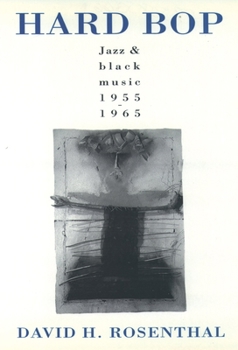Hard Bop: Jazz and Black Music 1955-1965
Select Format
Select Condition 
Book Overview
It's nineteen fifty-something, in a dark, cramped, smoke-filled room. Everyone's wearing black. And on-stage a tenor is blowing his heart out, a searching, jagged saxophone journey played out against a moody, walking bass and the swish of a drummer's brushes. To a great many listeners--from African American aficionados of the period to a whole new group of fans today--this is the very embodiment of jazz. It is also quintessential hard bop. In this,...
Format:Paperback
Language:English
ISBN:0195085566
ISBN13:9780195085563
Release Date:September 1993
Publisher:Oxford University Press, USA
Length:224 Pages
Weight:0.70 lbs.
Dimensions:0.6" x 5.5" x 8.6"
Customer Reviews
2 ratings
truly outstanding ( a cut above most books on jazz )
Published by Thriftbooks.com User , 17 years ago
Despite a lava flow of mediocre offerings, there have been a number of good books written on jazz over the years; the essays of Nat Hentoff, Gary Giddins and Stanley Crouch along with various histories and aesthetic treatises (Ralph Ellison and Albert Murray) enrich both our enjoyment and knowledge of this dynamic art form. While he has apparently published only one book on the topic, David H. Rosenthal's writing in "Hard Bop: Jazz and Black Music 1955-1965" exhibits a number of unique characteristics which demonstrate that he belongs in the same rarified company. Rosenthal's calm and guileless enthusiasm, a combination of streetwise smarts and poetic sensitivity, allows him to venture intelligent observations without lapsing into mere opinion mongering. Aspects of the jazz subculture (and necessarily, the life of the black Americans within it) are discussed without recourse to reductionist political or sociological theories. Perhaps this can be attributed to Rosenthal's distance from day-to-day involvement in the "jazz industry"; the Chicago native's main gig is as a literary man (translator of Portuguese and Catalan literature). This comes through in "Hard Bop", from the masterful introduction (an exposition of its theme via the life and death of quintessential hard bopper Lee Morgan) to the closing chapters ruminating on the end of the era and the changes wrought in jazz since its passing. Given hard bop's form, a synthesis of bebop's complexity with other influences (primarily, but by no means only, the earthier aspects of blues expression), it's fitting that Rosenthal's first chapter details the revolutionary musical changes initiated through late-night jam sessions at Minton's Playhouse, NYC. The leading figures who emerged from the ensuing period (1942-47) of creative ferment (Charlie Parker, Dizzy Gillespie, Thelonious Monk) are doubtless the forefathers of the younger musicians who became associated with hard bop. Sagaciously, Rosenthal cites the "seething intensity and brooding, obsessive side" of Bud Powell's playing and (often dark) compositions as stylistic elements from which hard bop would evolve. Further on, linking the music to the lifestyle, he points out that: "To young beboppers, the new music was a banner of rebellion, filled with the excitement of discovery, turning jazz inside out and electrifying a musical language in danger of excessive codification. To `hipsters' it was an alternative lifestyle, pursued with varying degrees of fanaticism. At its most extreme, the world of bebop meant rejecting respectability in favor of a bohemian quest for strong sensations, for the aesthetic and spiritual." Chapter 2 chronicles the rise of hard bop proper. As a new decade ushered in, bebop had declined and what came to be known as "cool jazz" was in ascendancy: "Many of [bebop's] best practitioners were dead, others, like Charlie Parker, were in decline. R & B might be a source of new ideas, but it was too limited to satisfy j
"Hard Bop": A Book that Transcends its Topic
Published by Thriftbooks.com User , 23 years ago
"Hard Bop" is bop with an edge, bop with an aggressive, blues-based attack. Its archetype practitioner was trumpeter Lee Morgan, killed outside a nightclub in January 1972 by his lover. Influenced by boppers such as Fats Navarro and Dizzy Gillespie, Morgan and other hard boppers developed a style emphasizing minor keys, a "dark" mood, slurs, and half-valve effects. Morgan's most popular number in the idiom was the huge 1964 hard bebop/R & B hit "The Sidewinder." Hard bop is introduced here through the prism of Lee Morgan: Morgan helped develop the style as an alternative to bop's successor, cool jazz, as developed, in part, by Gerry Mulligan and Miles Davis, and hard bop began to fade with his murder. But the book tackles more than Morgan, and, in fact, more than hard bop: It's a fascinating account of the various musical streams colliding--sometimes melding-- in the 10 years between 1955 and 1965. Rosenthal traces the evolution of hard bebop as bop declined ("bebop . . . had turned into something of a straitjacket . . . Many of its best practitioners were dead, and others . . . were in decline"). Musicians looked to R & B to revive bop, and a new "more emotionally expressive and more formally flexible style began to emerge." Rosenthal looks at the expressions of hard bop in such diverse artists as Sonny Rollins, the soulful Horace Silver ("The Preacher"), Cannonball Adderley, organist Jimmy Smith ("Midnight Special"), Jackie MacClean, and, to a lesser degree, Art Farmer, Andrew Hill, Mingus, and some of the pre-1965 John Coltrane (e.g., with Miles on "Cookin'"). Rosenthal perceptively notes that hard bebop was a "complicated set . . . of interlocking tendencies," rather than a static, easily defined style.I enjoy this book because it explores a somewhat brief phenomenon, and shows how it developed, flourished, and then gave way to new elements. The writing is crisp, intelligent, energetic, and full of illustrative anecdotes that illuminate and entertain (not the dry pedantic treatise one might expect on this rather narrow topic). Rosenthal shows the connections between various elements of jazz, and presents it as a living, evolving, powerful force. Eleven chapters following the introduction, no pictures. Very highly recommended to jazz fans of any stripe.




